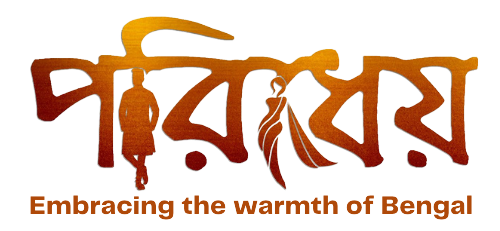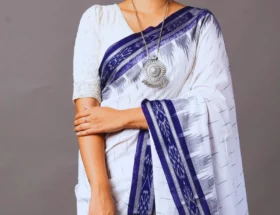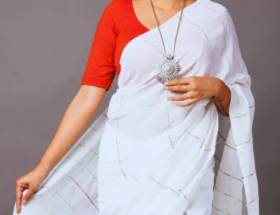Artistry in Indian Fashion
In the realm of Fabric, where threads are woven into dreams and emotions, the intricate works adorning these ethereal garments transport us to a world of artistry and splendor. Each delicate stroke of craftsmanship tells a story, evoking emotions that resonate deep within our souls. From traditional techniques passed down through generations to contemporary interpretations, the works in Fabric celebrate the rich heritage and timeless beauty of this iconic attire. Join us on a journey through the mesmerizing tapestry of works, as we unravel the magic and allure that each style brings in the Artistry in Indian Fashion.
Artistry in Indian Fashion – Zari Work: A Glimmer of Opulence
Like golden rays of sunlight dancing on a dew-kissed morning, zari work illuminates Fabric with its opulent allure. Crafted using metallic threads, often infused with gold or silver, this intricate embroidery technique creates stunning motifs that shimmer and shine. Zari work, with its regal splendor, adorns Fabric for grand occasions and celebratory moments, reflecting a sense of richness and luxury. Let the glimmering threads of zari work transport you to a world of grandeur and elegance.
Resham Embroidery: A Symphony of Colours
Resham embroidery, also known as silk thread work, weaves a colorful tapestry of beauty. With every vibrant stitch, this age-old technique brings Fabric to life, creating intricate patterns and motifs. The smooth silk threads glide across the fabric, adding depth, texture, and a touch of femininity. Resham embroidery celebrates the vivid palette of emotions, painting the Fabric with hues that reflect joy, love, and the essence of womanhood. Wrap yourself in the warmth and vibrancy of resham embroidery, and let the Fabric become a canvas for your emotions.
Artistry in Indian Fashion – Bandhani: A Dance of Tied Dyes
In the enchanting world of Fabric, Bandhani stands as a testament to the art of tie-dye. This ancient technique involves tying small portions of the fabric with threads before dyeing, resulting in mesmerizing patterns that resemble droplets or dots. The process is painstaking, but the end result is a masterpiece of vibrant colors and intricate designs. Bandhani Fabric, with their rhythmic dance of tied dyes, capture the essence of celebration and festivity. Let the playful patterns of Bandhani take you on a journey of joy and revelry.
Kantha Embroidery: A Story Stitched in Threads
Originating from the Bengal region, Kantha embroidery is an art form that breathes life into Fabric with its storytelling stitches. Skilled artisans meticulously hand-stitch intricate designs, often depicting folk tales, flora, or fauna. Each thread is carefully placed, weaving a narrative of culture, history, and personal expression. Kantha embroidery captures the essence of tradition and the heartfelt emotions of the wearer. Wrap yourself in the warmth of a Kantha embroidered Fabric, and let the threads tell your story.
Artistry in Indian Fashion – Mirror Work: A Glimpse of Radiance
Mirror work, also known as shisha embroidery, adds a touch of sparkling radiance to Fabric. Reflective glass pieces are skillfully stitched onto the fabric, creating a dazzling effect as they catch the light. This vibrant embellishment technique brings a sense of playfulness and joy to the Fabric, capturing attention and admiration wherever it goes. Let the mirrors reflect your inner glow and become a source of inspiration and fascination for those around you.
Artistry in Indian Fashion – Embellishments: A Touch of Extravagance
Fabric adorned with embellishments exude a sense of opulence and extravagance. From sequins and beads to stones and pearls, these intricate details elevate the Fabric to a new level of allure. Each embellishment is meticulously hand-sewn, adding a touch of glamour and enchantment to the fabric. As the light catches these embellishments, they shimmer and sparkle, mesmerizing all who lay eyes upon them. Let the adorned Fabric become a reflection of your inner radiance, allowing you to shine bright like a star.
Thread Work: A Delicate Embrace
Threadwork, with its delicate and intricate patterns, weaves a story of fine craftsmanship. Skilled artisans meticulously embroider the fabric with threads of various colors, creating stunning motifs and designs. Whether it’s the elegance of floral patterns or the grace of geometric shapes, threadwork adds depth and texture to the Fabric, elevating its visual appeal. Every stitch is a labor of love, a testament to the dedication and passion of the artisans who breathe life into the fabric. Wrap yourself in the delicate embrace of threadwork, and let the Fabric speak volumes about your refined taste and appreciation for artistry.
Artistry in Indian Fashion – Patchwork: A Patchwork of Traditions
Patchwork Fabric brings together fragments of fabric to create a tapestry of diverse traditions. Skillful hands sew colorful patches, each with its unique pattern and texture, forming a harmonious collage of cultures and stories. Patchwork Fabric celebrates the beauty of diversity and the art of amalgamation. They embody the spirit of unity, showcasing the seamless blending of different elements into a cohesive whole. Let the patchwork Fabric be a symbol of harmony, a reminder that the threads that bind us together are stronger than those that separate us.
Artistry in Indian Fashion – Gota Patti: A Lustrous Delight
Gota Patti’s work, with its metallic ribbon and thread work, adds a touch of lustrous delight to Fabric. Carefully placing and stitching these shimmering ribbons onto the fabric creates intricate designs and motifs. The golden hues of Gota Patti lend an air of regality and majesty to the Fabric, making it a perfect choice for special occasions and celebrations. Let the gleaming threads of Gota Patti work illuminate your presence, turning heads and evoking a sense of admiration and awe.
Conclusion
The works in Fabric are a testament to the artistry, skill, and creativity that goes into creating these magnificent garments. Each style, including the shimmering beauty of zari work and the intricate storytelling of Kantha embroidery, adds a unique dimension to the fabric, making it a work of art to be cherished.Whether you seek elegance, opulence, tradition, or a blend of styles, the diverse works in Fabric offer a kaleidoscope of options to suit your taste and preference. Wrap yourself in the poetry of these works, and let the Fabric become a canvas that reflects your emotions, celebrates your individuality, and captivates all who behold its exquisite beauty.
FAQs
What are the different types of works in traditional Indian Fabric?
Traditional Indian Fabricare adorned with various exquisite works that enhance their beauty and appeal. Here are some popular types of works found in traditional Indian Fabric:
- Zari Work: Zari work involves the use of metallic threads, typically made of gold or silver, to create intricate patterns and designs on the Fabric. These threads are woven into the fabric, adding a touch of grandeur and elegance to the Fabric. Key points:
- Zari work uses metallic threads.
- It creates intricate patterns and designs.
- Adds a touch of grandeur and elegance to the Fabric.
- Embroidery: Embroidery work involves the use of needles and threads to create decorative designs on the Fabric. Artisans use different types of embroidery techniques, such as zardozi, Kantha, or mirror work, to add texture and embellishments to the fabric. Key points:
- Embroidery work uses needles and threads.
- Various techniques like zardozi and kantha are used.
- Adds texture and embellishments to the Fabric.
- Bandhani: Bandhani, also known as tie and dye, is a traditional Indian technique where artisans tie sections of the fabric with threads and then dye them, creating small dots or patterns.. This process results in beautiful and vibrant patterns on the Fabric. Key points:
- Bandhani is a tie-and-dye technique.
- Small dots or patterns are created by tying sections of the fabric.
- Results in beautiful and vibrant patterns on the Fabric.
- Block Printing: Block printing is a technique where craftsmen dip wooden blocks with intricate designs in dye and stamp them onto the fabric to create patterns. It is a labor-intensive process that requires precision and skill. Key points:
- Block printing uses wooden blocks with intricate designs.
- Blocks are dipped in dye and stamped onto the fabric.
- Requires precision and skill.
How are works in traditional Indian Fabric created?
The creation of works in traditional Indian Fabric involves skilled artisans and meticulous craftsmanship. Here’s an overview of the process:
- Design Creation: The process begins with the creation of intricate designs, either on paper or electronically. These designs serve as blueprints for creating works on the fabric.
- Pattern Transfer: Craftsmen transfer the design onto the fabric using various methods. In the case of embroidery, they trace the pattern onto the fabric, while block printing involves using carved wooden blocks.
- Work Execution: Skilled artisans meticulously execute the works on the Fabric. Artisans weave metallic threads into the fabric using a needle or a specialized loom for zari work. Embroidery, bandhani, block printing, and beadwork involve handcrafting the designs on the Fabric.
- Quality Checks: Skilled artisans perform quality checks throughout the process to ensure accuracy and finesse in the work. They rectify any errors or imperfections before deeming the fabric ready.
How do works enhance the beauty of traditional Indian Fabric?
The works in traditional Indian Fabric play a crucial role in enhancing their beauty and allure. Here’s how they contribute:
- Intricate Detailing: Works like zari, embroidery, and beadwork add intricate detailing to the Fabric. They create mesmerizing patterns and motifs that catch the eye and make the Fabric visually captivating.
- Textural Contrast: Works such as embroidery and beadwork add texture to the Fabric, creating a delightful contrast with the smoothness of the fabric. This textural interplay adds depth and visual interest to the Fabric.
- Sparkle and Shine: Works like zari, sequins, and beadwork introduce elements of sparkle and shine to the Fabric. These embellishments catch the light, adding a touch of glamour and elegance to the overall look.
Important information:
- Works in traditional Indian Fabric add intricate detailing and texture.
- They create a contrast with the fabric and add visual interest.
- Works like zari, sequins, and beadwork introduce sparkle and shine.
How to care for works in traditional Indian Fabric?
Caring for works in traditional Indian Fabric is essential to preserve their beauty and longevity. Here are some tips:
- Gentle Handling: Handle the Fabric with care to avoid snagging or pulling on the works. Be cautious when wearing jewelry or accessories that may catch in the embroidery or beadwork.
- Storage: Store the Fabric in a clean and dry place, preferably in a muslin or cotton cloth, to protect it from dust and moisture. Avoid hanging heavy Fabric to prevent stretching or damage to the works.
- Dry Cleaning: It is advisable to have a professional dry clean the fabric due to the delicate nature of the work. Inform the dry cleaner about the specific works on the Fabric to ensure appropriate care.
Important information:
- Handle works in traditional Indian Fabric with care to avoid damage.
- Store the Fabric in a clean and dry place.
- Get the Fabric dry-cleaned by a professional.
Where can I find traditional Indian Fabric with intricate works?
You can find traditional Indian fabric with intricate works in various places. Here are some options:
- Local Boutiques and Handloom Stores: Visit local boutiques and handloom stores that specialize in traditional Indian Fabric. These establishments often carry a wide range of Fabric with different works, allowing you to choose according to your preference.
- Online Marketplaces: Explore reputable online marketplaces that offer a curated selection of traditional Indian Fabric. Read customer reviews, check seller ratings, and examine product descriptions to ensure authenticity and quality.
- Weaver Communities: Weaver communities directly source some traditional Indian fabrics. Look for organizations or cooperatives that work closely with artisans and support their craftsmanship. These sources often offer authentic and unique Fabric with exquisite works.
Important information:
- Local boutiques, handloom stores, and online marketplaces offer traditional Indian Fabric.
- Check for authenticity and quality before making a purchase.
- Consider sourcing Fabric from weaver communities for unique and authentic works.
In conclusion, the works in traditional Indian Fabric are a testament to the artistic skills and rich cultural heritage of India. Whether it’s zari work, embroidery, bandhani, block printing, or beadwork, these intricate works add a touch of elegance and charm to the Fabric. By understanding the different types of works, their creation process, and proper care, individuals can appreciate and cherish this exquisite Fabric for generations to come.




